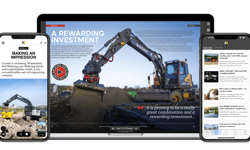
“Serious disruption” was the order of the day at Chemical Watch when it marked its tenth anniversary in 2017, says its commercial director, Richard Butterworth. Not because it was struggling to survive in the present, but because it was looking at how best to flourish in the future. The almost 50% increase in recurring revenues that happened next is justification of its thinking … and proof of the potential in the membership opportunity.
Chemical Watch launched in 2007 with subscription newsletters to provide independent product safety and insight to professionals managing chemicals. And it evolved a strong reputation as a provider of top-quality news and insight, and as a robust media business with recurring revenues, over the years that followed.
But turning ten three years ago, combined with a desire to find a way to drive deeper higher value relationships with customers that would grow recurring revenue, provided a catalyst for a major business re-think.
“It was a time to take stock,” says Butterworth, who joined Chemical Watch five years into its journey, in 2012.
“Much had changed: the regulatory agenda, the functional maturity of our customers. The technology landscape had changed enormously – as had the competitive landscape. The riskiest strategy was to carry on as we were and assume we would be able to continue to meet our customers’ needs for the next ten years.
“So, the decision was made to disrupt what was a perfectly healthy business and move to something different: membership.”
Previously, Chemical Watch had had a subscriptions model. But this revolved around a disparate mix of different subscriptions and services that had evolved over the years.
“The new membership proposition gave us licence to do away with prescriptive product wrappers and, instead of focusing on products, focus on one holistic product driven by customer need to maximise value for our members,” Butterworth explains.
“That switch from being product-led to customer value-led was crucial. Another key difference was that membership for us emphasises the community and the networking aspects of what we do – membership infers belonging to some kind of community and, ideally, participating in it – it is very much a two-way exchange we encourage our members to enjoy as part of their membership.
“That resulted in us achieving what strategically we wanted to from building deeper relationships with our best customers: moving further up the value chain in terms of proposition, resulting in – ultimately – higher revenues.”
At every step of the process, we were careful to pause and validate what we were doing.
Insight-driven
Customer insight is key to the membership model. Six months was spent deep diving into what the team knew and understood about its customers.
“We employed an external agency to conduct customer interviews and produce fantastic insights. We conducted our own internal research alongside that – quantitative surveys, qualitative meetings with customers. We pulled together a lot of existing data and knowledge from across the business,” he continues.
“We formed an advisory panel made up of some our key customers to help steer us to the right membership proposition. From all of that research, we created a customer needs map that was our road map for what we needed to deliver in our re-imagined service. Off the back of that, a series of use cases were produced to show practically how it would work.”
He adds: “At every step of the process, we were careful to pause and validate what we were doing.” The result was a new proposition built around three pillars – each representing a tangible value it sought to deliver: inform, connect, transform.
Also important was designing an appropriate membership experience, which placed a major emphasis on user interface and user experience design.
Significant technology investment was made to ensure the membership proposition delivered tangible value to members, Butterworth explains. One, ‘semantic fingerprinting’, to maximise value around existing content; another, developed with an external partner, was a diagnostic tool to benchmark best practice for members.
There was a complete re-platforming – changing the former model, with lots of news magazine-style subscription products to a single central membership offering online which would also provide a solid foundation for evolving the proposition significantly over the next ten years.
A shift in mindset was needed, too – away from thinking subscribers, to thinking of accounts as prospects rather than individuals, with access to membership now sold enterprise-wide.
Root and branch change on the sales side was needed.
A new business development function, for example, and the recruitment of a more consultative sales team able to navigate members’ internal cross-departmental buying committees, including procurement. There is also now a customer success department dedicated to gathering evidence of value delivery to help drive renewals and win new members.
In short, the membership sales function is more strategic and outbound-focused.
Finally, a full re-brand was undertaken – to distinguish the new proposition as new and different, rather than just another iteration of the old subscription product – and education began so all internally were able to sell the benefits as existing subscribers were converted to members, and new members were brought in.
A year on, Butterworth says, renewals – a key KPI – are “enormously reassuring”. As has been the fact that the transformation was achieved by pretty much the same marketing team Chemical Watch had had before.
With the membership journey now well established, attention is on further evolution – including ways Chemical Watch can help its members not just comply with chemical product safety best practice, but also drive added value by doing so. And the future looks bright.
“There’s a huge opportunity for premium quality content, now more than ever,” Butterworth notes. That’s the value of a trusted source.

You can hear Richard Butterworth being interviewed by Ciar Byrne on a recent episode of The InPublishing Podcast, which was sponsored by Acorn Web Offset, the Yorkshire-based specialist A5 and A4 magazine printer.
This article was first published in InPublishing magazine. If you would like to be added to the free mailing list, please register here.












